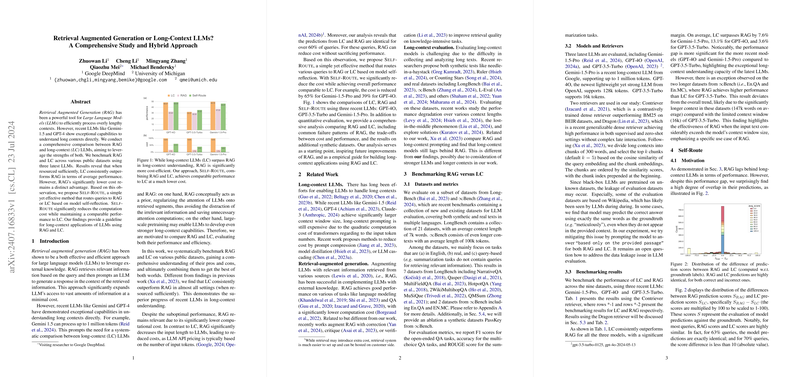Retrieval Augmented Generation or Long-Context LLMs? A Comprehensive Study and Hybrid Approach
The paper "Retrieval Augmented Generation or Long-Context LLMs? A Comprehensive Study and Hybrid Approach," authored by Zhuowan Li and colleagues from Google DeepMind and the University of Michigan, presents a thorough comparison of Retrieval Augmented Generation (RAG) and Long-Context (LC) LLMs. This paper is performed using three state-of-the-art LLMs: Gemini-1.5, GPT-4O, and GPT-3.5-Turbo. The authors propose a hybrid approach named Self-Route, which seeks to optimize the trade-offs between performance and computational cost.
Comparison of RAG and LC Approaches
RAG has been an essential tool for extending the context window of LLMs by retrieving relevant information chunks and then using LLMs to generate responses. This process is computationally efficient and helps in scenarios where the model’s input context size is constrained. On the other hand, modern LLMs like Gemini-1.5 and GPT-4O can process extremely long contexts directly, leveraging their advanced architectural capabilities.
Benchmarking Analysis
The authors conducted extensive benchmarking across nine datasets extracted from LongBench and $ datasets, including NarrativeQA, Qasper, MultiFieldQA, and HotpotQA, among others. Metrics such as F1 scores, accuracy, and ROUGE were used for evaluation. Key findings reveal that LC methods outperform RAG consistently across most settings when sufficient computational resources are available:
- Gemini-1.5-Pro: LC outperformed RAG by an average of 7.6%.
- GPT-4O: LC outperformed RAG by an average of 13.1%.
- GPT-3.5-Turbo: LC had a 3.6% average performance advantage over RAG.
Notably, the performance of retrieval-based approaches like RAG was particularly strong on datasets with extremely long contexts, where direct processing by LLMs like GPT-3.5-Turbo proved infeasible due to token limitations.
Self-Route Method
Motivated by a need to balance performance and computational cost, the Self-Route method is introduced. Self-Route targets queries to either RAG or LC based on their nature. Key advantages of the approach include:
- Cost Efficiency: Reduces computational costs by leveraging RAG for queries flagged as answerable based on the chunked context.
- Maintained Performance: Achieves performance levels similar to LC while requiring fewer computational resources. For instance, in the case of the Gemini-1.5-Pro, Self-Route reduces costs by 65% for Gemini-1.5-Pro and 39% for GPT-4O while maintaining comparable performance.
Numerical Insights
Interestingly, the analysis shows that RAG predictions matched LC predictions over 60% of the time. This overlap indicates an opportunity for cost-saving by dynamically switching between RAG and LC approaches based on initial predictions.
Implications and Future Directions
The paper provides a guideline for deploying LLMs in long-context applications, highlighting the feasibility of hybrid methods like Self-Route. From a practical standpoint, applications involving long document processing, retrieval-based QA systems, and real-time information synthesis stand to benefit significantly from these findings.
Theoretical implications include potential refinement of self-reflective mechanisms within models to optimize routing and enhanced failure analysis frameworks to further dissect retrieval shortcomings (e.g., ambiguous or multi-step queries).
Conclusion
By presenting a comprehensive analysis and an innovative hybrid approach, the paper elucidates the nuanced trade-offs between RAG and LC LLMs. As the capabilities of LLMs continue to evolve, hybrid methodologies like Self-Route may become integral to harnessing their full potential while managing computational resources efficiently. Future research might explore further tuning of routing algorithms, integration with advanced retrieval techniques, and application-specific adaptations of hybrid LLM models. This paper lays a robust foundation for these explorations, carrying significant implications for both theoretical developments and practical deployments in AI research.
